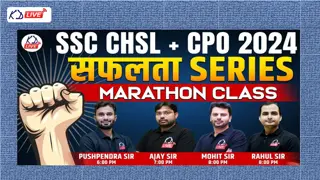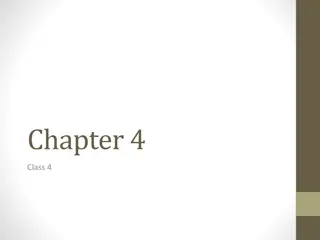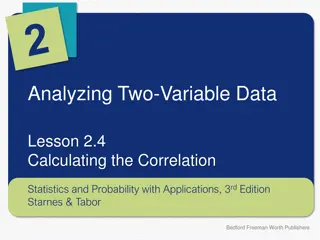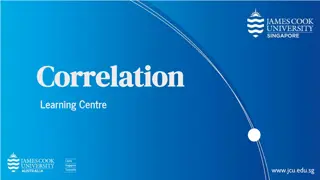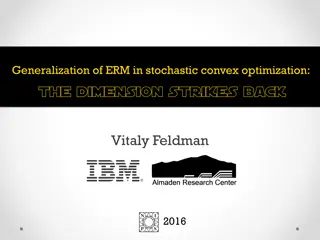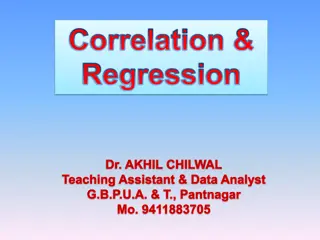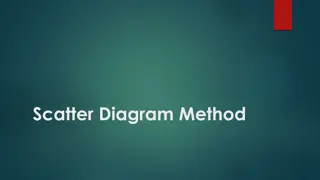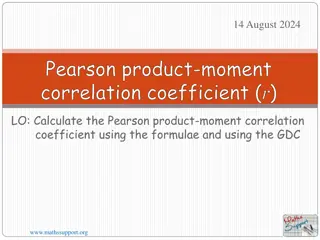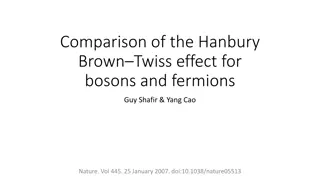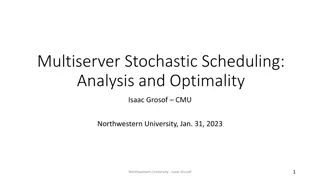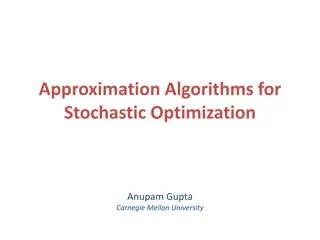Effect of Bit-Level Correlation in Stochastic Computing
Impact of bit-level correlation in stochastic computing and its implications on system efficiency and performance. This study delves into the theoretical and simulated results, highlighting the properties and applications of stochastic computing. The research also analyzes previous works and aims to generate correlated bit streams for multi-sensor processing systems.
Download Presentation

Please find below an Image/Link to download the presentation.
The content on the website is provided AS IS for your information and personal use only. It may not be sold, licensed, or shared on other websites without obtaining consent from the author.If you encounter any issues during the download, it is possible that the publisher has removed the file from their server.
You are allowed to download the files provided on this website for personal or commercial use, subject to the condition that they are used lawfully. All files are the property of their respective owners.
The content on the website is provided AS IS for your information and personal use only. It may not be sold, licensed, or shared on other websites without obtaining consent from the author.
E N D
Presentation Transcript
Effect of Bit-Level Correlation in Stochastic Computing MEGHA MEGHA PARHI, MARC D. RIEDEL, PARHI, MARC D. RIEDEL, KESHAB KESHAB K. PARHI K. PARHI DEPARTMENT OF ELECTRICAL AND COMPUTER ENGINEERING UNIVERSITY OF MINNESOTA, MINNEAPOLIS MN, USA
Outline Introduction Objective Theoretical Results Simulated Results Conclusions and Future Work
Stochastic Computing Stochastic number can be represented in two formats, where each bit has the same weight. Unipolar: ? = ? ? = 1 = ?(?) and ? [0,1] Bipolar: ? = 2? ? = 1 1 = 2? ? 1 and ? [ 1,1]
Properties of Stochastic Computing Stochastic Computing: A number is represented by a string of 1 s and 0 s. The percent of 1 s in the number represents the value of the number represented as a probability. It was proposed in 1967 by Gaines as an alternative to binary computing. Stochastic logic gates compute an approximation of the output as opposed to an exact value. Applications: These are well suited in low-speed area-constrained applications such as biomedical applications, and cyber-physical systems operating at low rates. Advantages: Low complexity in computing, small in size, low power Fault-tolerance due to redundancy Disadvantages Long computation time (if bit stream is long) Low Accuracy (if bit stream is short) Multiplying by 2 and checking sign in bipolar are expensive operations
Example of Stochastic Multiplication 100110 0.500 0.333 000010 0.166 010010
Outline Introduction Objective Theoretical Results Simulated Results Conclusions and Future Work
Previous Work Parker and McCluskey discuss how to treat probability in a logic gate without using stochastic bit streams where multiple bit streams are uncorrelated at bit-level (1975). Qian et al present approaches to synthesize a certain probability assuming that the bit streams are independent (2009, 2011). Alaghi and Hayes use an approach that uses Stochastic Correlation and have proposed a method to generate correlated bit streams using probabilistic transfer matrices (2013). Objective-1: Analyze output when multiple bit streams are correlated at the bit-level. Objective-2: Generate correlated bit streams.
Multi-Sensor Processing System ?1 ?1 MIMO System ?2 ?2 ?3
Bit-Level Correlation This work presents a method to analyze effect of bit-level correlation and generate correlated bit streams using Pearson correlation for unipolar [0,1] ? ?? ???? ???? ???= Each bit is a Bernouli random variable. Sum of Bernouli is a Binomial RV, For long bit stream, binomial approximates a Gaussian RV
Outline Introduction Previous Work Objective Theoretical Results Simulated Results Conclusions and Future Work
Closed Form Expressions for Single Logic Gates Gate Type Independent Correlated AND ?1?2 ?1?2+ ?1?2 AND (?1 inverted) ?2(1 ?1) ?2 ?1?2 ?1?2 NAND 1 ?1?2 1 ?1?2 ?1?2 OR ?1+?2 ?1?2 ?1+?2 ?1?2 ?1?2 OR (?1 inverted) ?2+(1 ?1) ?2(1 ?1) 1 ?1 ?1?2 ?1?2 NOR (1 ?1)(1 ?2) 1 ?1 ?2+ ?1?2+ ?1?2 XOR ?1+?2 2?1?2 ?1+?2 2?1?2 2 ?1?2 XNOR 1 ?1+?2+2?1?2 1 ?1+?2+2?1?2+ 2 ?1?2 MUX (?3 select signal) ?1 ?1?3+ ?2?3 ?1 ?1?3+ ?2?3
Error Analysis ? Deviation = Error) Gate Type Error AND NAND OR NOR XOR XNOR ?1?2 ?1?2 ?1?2 ?1?2 2 ?1?2 2 ?1?2
Synthesis Correlated Bit Streams from Uncorrelated Bit Streams (Unipolar) ?1= 0 ?1= 1 Marginal ?2= 0 ?2= 1 Marginal 1 ?2 ?1+ ? ?1 ? 1 ?2 ?2 ? ? ?2 1 ?1 ?1 1 Let ?(?1= 1,?2= 1) = ? Calculate: ? = ??1?2+ ?1?2
Synthesis of Two Correlated Stochastic Bit Streams Input: ?1, ?2 and ?. Output: ?1 and ?2.
Synthesized Circuit using LFSR, MUX p1[9:0] X1 Comparator a/p1[9:0] M U X X2 (p2-a)/(1-p1)[9:0] Comparator
Range MINIMUM CORRELATION COEFFICIENT MAXIMUM CORRELATION COEFFICIENT
Constraints for Correlation ? ? max( ?1?2 ? min(?1 ?1?2 ?1?2, ?1?2+?1+?2 1 ,?2 ?1?2 ) ?1?2 ) ?1?2 ?1?2
Synthesis of Three Correlated Stochastic Bit Streams Input: ?1, ?2 and ?3; ?12, ?13, ?23 and ?123. Output: ?1, ?2 and ?3.
Outline Introduction Previous Work Objective Theoretical Results Simulated Results Conclusions and Future Work
Simulated Results ? = 0.2 ? = ?1?2+ ?1?2 0.4 0.5 0.5 0.6 100 = 0.2 + 0.2 ? Deviation = Error = ? ? = 0.2489 0.2 = 0.0489 = 0.2489 0.4 0.5 0.2489
Simulation Results of Stochastic Logic Given Correlated inputs
Example using Logic Gates X1 Y1 X1 X3 Y1 X2 Z Z X2 X3 Y2 ? ?1 = ?1?3+ ? ?1?31 ?1 1 ?3 2?3+ ??1?2?1?2 2?31 ?1?2 1 ?2?3 ? ? = ? ?1?2 = ?1?2 ? ? = ? ?2?1 = ?2 ?1?3+ ? ?1?31 ?1 1 ?3 = ?2 ?1?2?3+ ??1?2?1?31 ?1?2 1 ?2?3 ??1?2=?1?31 ?2+? ?1?3(1 ?1)(1 ?3) ?1?3(1 ?1?2)(1 ?2?3)
Conclusion Presented an approach to analyze effect of bit-level correlation Presented synthesis of correlated bit streams Simulation results confirm results predicted from theory
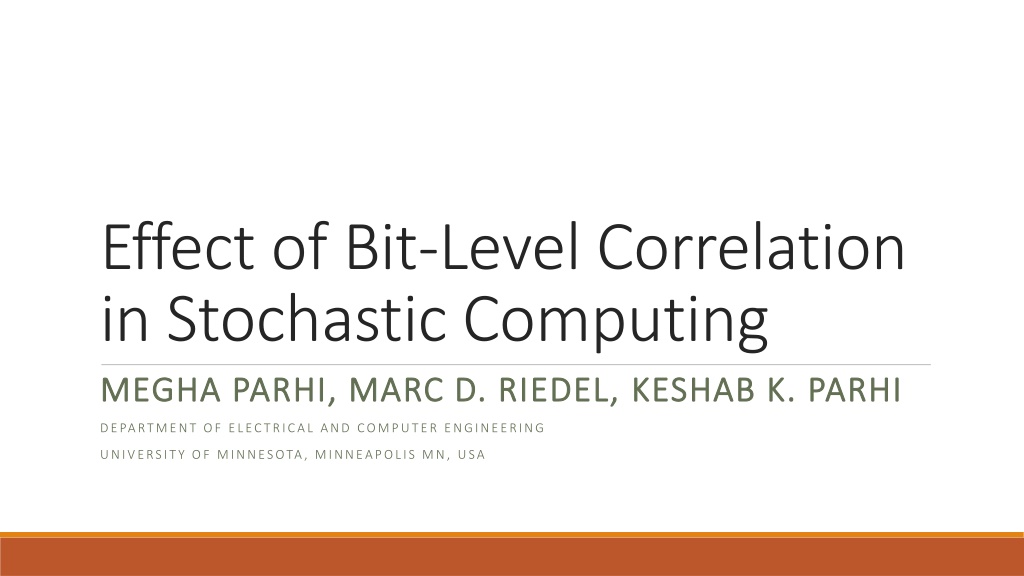
 undefined
undefined





